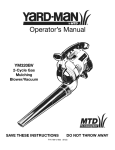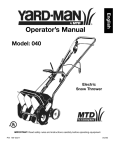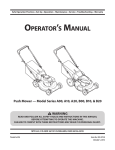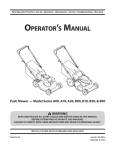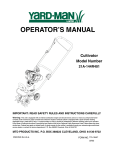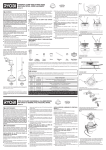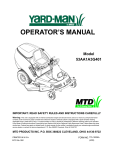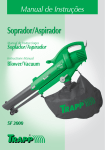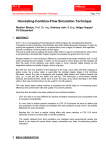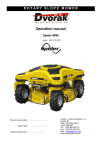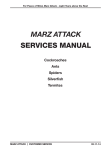Download Yard-Man YM320BV User's Manual
Transcript
Operator’s Manual YM320BV 2-Cycle Gas Mulching Blower/Vacuum SAVE THESE INSTRUCTIONS DO NOT THROW AWAY P/N 769-01400 (1/05) PRINTED IN USA INTRODUCTION THANK YOU TABLE OF CONTENTS Thank you for buying this quality product. This modern outdoor power tool will provide many hours of useful service. You will find it to be a great labor-saving device. This operator’s manual provides you with easy-tounderstand operating instructions. Read the whole manual and follow all the instructions to keep your new outdoor power tool in top operating condition. Service Information . . . . . . . . . . . . . . . . . . . . . . . . .2 Rules for Safe Operation . . . . . . . . . . . . . . . . . . . . .3 Know Your Unit . . . . . . . . . . . . . . . . . . . . . . . . . . . .7 Assembly Instructions . . . . . . . . . . . . . . . . . . . . . . .8 Oil and Fuel Information . . . . . . . . . . . . . . . . . . . . .11 PRODUCT REFERENCES, ILLUSTRATIONS AND SPECIFICATIONS All information, illustrations, and specifications in this manual are based on the latest product information available at the time of printing. We reserve the right to make changes at any time without notice. Copyright© 2005 MTD SOUTHWEST INC, All Rights Reserved. Starting/Stopping Instructions . . . . . . . . . . . . . . . .12 Operating Instructions . . . . . . . . . . . . . . . . . . . . . .13 Maintenance and Repair Instructions . . . . . . . . . . .15 Cleaning and Storage . . . . . . . . . . . . . . . . . . . . . . .18 Accessories and Replacement Parts . . . . . . . . . . .18 Troubleshooting Chart . . . . . . . . . . . . . . . . . . . . . .19 Specifications . . . . . . . . . . . . . . . . . . . . . . . . . . . . .20 SERVICE INFORMATION Warranty Information . . . . . . . . . . . . . . . . . . . . . . .22 Service on this unit both within and after the warranty period should be performed only by an authorized and approved service dealer. Parts List . . . . . . . . . . . . . . . . . . . .Inside Back Cover For service call 1-800-345-8746 in the United States, or 1-800-668-1238 in Canada to obtain a list of authorized service dealers near you. For more details about your unit, visit our website at www.Yardman.com. DO NOT RETURN THE UNIT TO THE RETAILER. PROOF OF PURCHASE WILL BE REQUIRED FOR WARRANTY SERVICE. Before beginning, locate the unit’s model plate. It lists the model and serial numbers of your unit. Refer to the sample plate below and copy the information for future reference. MODEL : S/N : ITEM : SPARK ARRESTOR NOTE NOTE: For users on U.S. Forest Land and in the states of California, Maine, Oregon and Washington. All U.S. Forest Land and the state of California (Public Resources Codes 4442 and 4443), Oregon and Washington require, by law that certain internal combustion engines operated on forest brush and/or grass-covered areas be equipped with a spark arrestor, maintained in effective working order, or the engine be constructed, equipped and maintained for the prevention of fire. Check with your state or local authorities for regulations pertaining to these requirements. Failure to follow these requirements could subject you to liability or a fine. This unit is factory equipped with a spark arrestor. If it requires replacement, ask your LOCAL SERVICE DEALER to install the Accessory Part #753-04689 Spark Arrestor Kit. CALIFORNIA PROPOSITION 65 WARNING Copy the model and parent part number here: Copy the serial number here: Make sure you carefully read and understand this manual before starting or operating this equipment. THIS PRODUCT IS COVERED BY ONE OR MORE U.S. PATENTS. OTHER PATENTS PENDING. 2 WARNING THE ENGINE EXHAUST FROM THIS PRODUCT CONTAINS CHEMICALS KNOWN TO THE STATE OF CALIFORNIA TO CAUSE CANCER, BIRTH DEFECTS OR OTHER REPRODUCTIVE HARM. RULES FOR SAFE OPERATION The purpose of safety symbols is to attract your attention to possible dangers. The safety symbols, and their explanations, deserve your careful attention and understanding. The safety warnings do not by themselves eliminate any danger. The instructions or warnings they give are not substitutes for proper accident prevention measures. SYMBOL MEANING Indicates danger, warning or caution. Attention is required in order to avoid serious personal injury. May be used in conjunction with other symbols or pictographs. SAFETY ALERT: NOTE: Advises you of information or instructions vital to the operation or maintenance of the equipment. Read the Operator’s Manual(s) and follow all warnings and safety instructions. Failure to do so can result in serious injury to the operator and/or bystanders. FOR QUESTIONS, CALL 1-800-345-8746 in the United States, or 1-800-668-1238 in Canada SYMBOL MEANING Failure to obey a safety warning will result in serious injury to yourself or to others. Always follow the safety precautions to reduce the risk of fire, electric shock and personal injury. DANGER: Failure to obey a safety warning can result in injury to yourself and others. Always follow the safety precautions to reduce the risk of fire, electric shock and personal injury. WARNING: to obey a CAUTION: Failure safety warning may result in property damage or personal injury to yourself or to others. Always follow the safety precautions to reduce the risk of fire, electric shock and personal injury. • IMPORTANT SAFETY INSTRUCTIONS • READ ALL INSTRUCTIONS BEFORE OPERATING When using the unit, you must follow the safety rules. Please read these instructions before operating the unit in order to ensure the safety of the operator and any bystanders. Please keep these instructions for later use. WARNING: • Read the instructions carefully. Be familiar with the controls and proper use of the unit. • Do not operate this unit when tired, ill, or under the influence of alcohol, drugs, or medication. • Children and teens under the age of 15 must not use the unit, except for teens guided by an adult. • All guards and safety attachments must be installed properly before operating the unit. • Inspect the unit before use. Replace damaged parts. Check for fuel leaks. Make sure all fasteners are in place and secure. Replace parts that are cracked, chipped, or damaged in any way. Do not operate the unit with loose or damaged parts. • Clear the area of children, bystanders, and pets. At a minimum, keep all children, bystanders, and pets outside a 50 feet (15 m.) radius; there still may be a risk to bystanders from thrown objects. Bystanders should be encouraged to wear eye protection. If you are approached, stop the unit immediately. • Carefully inspect the area before starting the unit. Remove all debris and hard or sharp objects such as glass, wire, etc. SAFETY WARNINGS FOR GAS UNITS Gasoline is highly flammable, and its vapors can explode if ignited. Take the following precautions: WARNING: • Store fuel only in containers specifically designed and approved for the storage of such materials. • Avoid creating a source of ignition for spilled fuel. Do not start the engine until fuel vapors dissipate. • Always stop the engine and allow it to cool before filling the fuel tank. Never remove the cap of the fuel tank, or add fuel, when the engine is hot. Never operate the unit without the fuel cap securely in place. Loosen the fuel tank cap slowly to relieve any pressure in the tank. • Mix and add fuel in a clean, well-ventilated outdoor area where there are no sparks or flames. Slowly remove the fuel cap only after stopping engine. Do not smoke while fueling or mixing fuel. Wipe up any spilled fuel from the unit immediately. Always wipe unit dry before using. • Move the unit at least 30 feet (9.1 m) from the fueling source and site before starting the engine. Do not smoke or allow sparks and open flames near the area while adding fuel or operating the unit. 3 RULES FOR SAFE OPERATION WHILE OPERATING • Always hold the unit with a firm grip when operating. • Never start or run the unit inside a closed room or building. Breathing exhaust fumes can kill. Operate this unit only in a well-ventilated outdoor area. • Keep hands, face, and feet at a distance from all moving parts. Do not touch or try to stop the impeller when it is rotating. Do not operate without guards in place. • To reduce the risk of injury associated with thrown objects, wear safety glasses or goggles that are marked as meeting ANSI Z87. standards. • Do not put any object into openings. Do not use with any opening blocked; keep free of dirt, debris, and anything that may reduce the air flow. • Never run the unit without the the proper equipment attached. When using this unit, always install the blower/vacuum tubes and vacuum bag depending on model. Make sure the vacuum bag is completely zipped closed. • Do not touch the engine or muffler. These parts get extremely hot from operation. When turned off they remain hot for a short time. • To reduce the risk of hearing loss associated with sound level(s), always wear ear/hearing protection when operating this unit. • Wear heavy, long pants, boots, and gloves. Do not wear short pants, sandals, or go barefoot. • To avoid static electricity shock, do not wear rubber gloves or any other insulated gloves while operating this unit. • To reduce the risk of injury associated with objects being drawn into rotating parts, do not wear loose clothing, jewelry, scarves, and the like. Secure hair above shoulder level. • Wear a face or dust mask if the operation is dusty. Long sleeve shirts are recommended. • Use the unit only in daylight or good artificial light. • Keep outside surfaces free from oil and fuel. • Avoid accidental starting. Be in the starting position whenever pulling the starter rope. The operator and unit must be in a stable position while starting. Refer to Starting/Stopping Instructions. • Do not set unit on any surface except a clean, hard area while engine is running. Debris such as gravel, sand, dust, grass, etc. could be picked up by the air intake and thrown out by the discharge opening, damaging unit, property, or causing serious injury to bystanders or operator. • Use the right tool. Only use this tool for the purpose intended. • Do not force unit. It will do the job better and with less likelihood of injury at a rate for which it was designed. • Do not overreach or use from unstable surfaces such as ladders, trees, steep slopes, rooftops, etc. Always keep proper footing and balance. 4 • Do not operate the engine faster than the speed needed to do the job. Do not run the engine at high speed when not in use. • Always stop the engine when operation is delayed or when walking from one location to another. • Stop the engine for maintenance, repair, to install or remove the blower tubes or vacuum attachments. The unit must be stopped and the impeller no longer turning to avoid contact with the rotating blades. • Use only original equipment manufacturer replacement parts when servicing this unit. These parts are available from your authorized service dealer. Do not use unauthorized parts, accessories, or attachments for this unit. Doing so could lead to serious injury to the user, or damage to the unit, and void your warranty. • Never use this unit for spreading chemicals, fertilizers or other substances which may contain toxic materials. • To reduce fire hazard, replace faulty muffler and spark arrestor, keep the engine and muffler free from grass, leaves, excessive grease or carbon build up. WHILE OPERATING UNIT AS A BLOWER • Never point the blower in the direction of people or pets, or in the direction of windows. Always direct the blowing debris away from people, animals, and windows. Use extra caution when blowing debris near solid objects such as trees, automobiles, walls, etc. WHILE OPERATING UNIT AS A VACUUM • Avoid situations that could catch the vacuum bag on fire. Do not operate near an open flame. Do not vacuum warm ash from fireplaces, barbecue pits, brush piles, etc. Do not vacuum discarded cigars or cigarettes unless the cinders are completely cool. RULES FOR SAFE OPERATION • The unit is designed to pickup dry material such as leaves, grass, small twigs, and bits of paper. Do not attempt to vacuum wet debris and/or standing water as this may result in damage to the blower/ vacuum. To avoid severe damage to the impeller, do not vacuum metal, broken glass, etc. OTHER SAFETY WARNINGS • Always disconnect the spark plug before performing maintenance or accessing movable parts. • Never store the unit, with fuel in the tank, inside a building where fumes may reach an open flame (pilot lights, etc.) or sparks (switches, electrical motors, etc.). • Allow the engine to cool before storing or transporting. Be sure to secure the unit while transporting. • Store the unit in a dry place, either locked up or up high to prevent unauthorized use or damage. Keep out of the reach of children. • Never douse or squirt the unit with water or any other liquid. Keep handles dry, clean, and free from debris. Clean after each use, see Cleaning and Storage instructions. • Keep these instructions. Refer to them often and use them to instruct other users. If you loan this unit to others, also loan these instructions to them. SPECIAL NOTE: Exposure to vibrations through prolonged use of gasoline powered hand tools could cause blood vessel or nerve damage in the fingers, hands, and joints of people prone to circulation disorders or abnormal swelling. Prolonged use in cold weather has been linked to blood vessel damage in otherwise healthy people. If symptoms occur such as numbness, pain, loss of strength, change in skin color or texture, or loss of feeling in the fingers, hands or joints, discontinue use of this tool and seek medical attention. An anti-vibration system does not guarantee avoidance of these problems. Users who operate power tools on a regular basis must closely monitor their physical condition and the condition of this tool. SAVE THESE INSTRUCTIONS 5 RULES FOR SAFE OPERATION SAFETY AND INTERNATIONAL SYMBOLS This operator's manual describes safety and international symbols and pictographs that may appear on this product. Read the operator's manual for complete safety, assembly, operating and maintenance and repair information. SYMBOL MEANING SYMBOL MEANING • ON/OFF STOP CONTROL • SAFETY ALERT SYMBOL ON / START / RUN Indicates danger, warning, or caution. May be used in conjunction with other symbols or pictographs. • ON/OFF STOP CONTROL OFF OR STOP • WARNING - READ OPERATOR'S MANUAL Read the Operator’s Manual(s) and follow all warnings and safety instructions. Failure to do so can result in serious injury to the operator and/or bystanders. • HOT SURFACE WARNING Do not touch a hot muffler or cylinder. You may get burned. These parts get extremely hot from operation. When turned off they remain hot for a short time. • WEAR EYE AND HEARING PROTECTION 1 WARNING: Thrown objects and loud noise can cause severe eye injury and hearing loss. Wear eye protection meeting ANSI Z87.1-1989 standards and ear protection when operating this unit. Use a full face shield when needed. • KEEP BYSTANDERS AWAY WARNING: Keep all bystanders, especially children and pets, at least 50 feet (15 m.) from the operating area. • UNLEADED FUEL 2 3 • CHOKE CONTROL 1 • FULL choke position. 2 • PARTIAL choke position. 3 • RUN position. • BLOWERS – ROTATING IMPELLER BLADES CAN CAUSE SEVERE INJURY WARNING: Stop the engine and allow the impeller to stop before opening the vacuum door, installing or changing tubes or bag, or before cleaning or performing any maintenance. Always use clean, fresh unleaded fuel. • THROTTLE CONTROL • OIL Indicates “HIGH” or “FASTEST” speed. Refer to operator's manual for the proper type of oil. • THROTTLE CONTROL • THROWN OBJECTS AND ROTATING CUTTER CAN CAUSE SEVERE INJURY WARNING: Keep clear of blower outlet. Never point the blower at yourself or others. Objects can be thrown from blower. Do not operate unit without proper attachments and guards in place. 6 Indicates “IDLE”, “LOW” or “SLOWEST” speed. RULES FOR SAFE OPERATION Throttle Control KNOW YOUR UNIT APPLICATION As a blower: • Cleaning yards, garages, driveways, porches, patios, around walls, fences and more As a vacuum: • Picking up leaves and other light debris Starter Rope Grip Fuel Cap Blower Tube On/Off Stop Control Blower Outlet Assembled as a Blower Spark Plug Assembled as a Vacuum Rear Handle Blue Choke Control Front Handle Vacuum Door Vacuum Bag Hook Vacuum Tube Primer Bulb Muffler Vacuum Bag Zipper Air filter/muffler cover Vacuum Bag Vacuum Inlet 7 ASSEMBLY INSTRUCTIONS ASSEMBLING UNIT AS A BLOWER ASSEMBLING UNIT AS A VACUUM Blower Tube Assembly To assemble the unit as a vacuum, begin by removing the blower tube. Refer to the previous section. Vacuum Tube Assembly To prevent serious personal injury, stop the engine and allow the impeller to stop before attaching or removing tubes. WARNING: To prevent serious personal injury or damage to the unit, the blower tube must be installed while operating this unit as a blower. WARNING: NOTE: If the unit was assembled as a vacuum unit, remove all vacuum parts and store away in a secure place for later use. Installing • Install the blower tube over the blower outlet and push it on until both tabs snap into place (Fig. 1). Removing • Remove the blower tube by pressing both tabs at the same time and pulling off the blower tube (Fig. 1). Tabs To prevent serious personal injury, stop the engine and allow the impeller to stop before attaching or removing tubes. WARNING: To prevent serious personal injury or damage to the unit, always install vacuum tubes and the vacuum bag, and make sure the vacuum bag is completely zipped closed when operating this unit as a vacuum. WARNING: NOTE: If the unit was assembled as a blower unit, remove the blower tube and store away in a secure place for later use. Installation 1. Align the small arrow on the lower vacuum tube with the arrow on the upper vacuum tube (Fig. 2). 2. Grasp the lower and upper vacuum tubes firmly with both hands, and push the lower vacuum tube into the upper vacuum tube. Turn the lower vacuum tube clockwise until it snaps into detente and locks. When properly assembled, the dot on the lower tube aligns with the dot on the upper tube. Upper Vac Tube Blower Outlet Fig. 2 Lower Vac Tube 3. Flip the unit so it is standing straight up on the muffler cover. The front of the unit and the vacuum door should face you (Fig. 3). Fig. 1 Vacuum Door Fig. 3 8 ASSEMBLY INSTRUCTIONS 4. Insert a flat head screwdriver into the slot at the lower end of the vacuum door. Make contact with the vacuum door locking clip and push inward and upwards (Fig. 4). Then pull the vacuum door and hold it open. Installing the Vacuum Bag 7. Install the vacuum bag tube over the blower outlet and push it on until both tabs snap into place (Fig. 6). Position the bag so its interior elbow slants downward. 8. Attach the vacuum bag to the vacuum bag hook located at the underside of the unit. Vacuum Door Slot Locking Clip Tabs Elbow Fig. 4 5. While holding the vacuum door open, locate the assembled vacuum tube (put together in Step 2). Arrange the tube so the flat area faces the vacuum door. The grooves on the side of the tube will line up with the small tabs in the impeller intake (Fig. 5). From the exterior, align the small arrow on the vacuum tube with the arrow on the impeller intake. 6. Push the vacuum tube in firmly and grip it with both hands. Turn the tube clockwise as far as possible until it snaps into the detente and locks. When properly assembled, the dot on the vacuum tube will align with the dot on the impeller intake. Vacuum Tube Groove Flat Area Vacuum Bag Hook Fig. 6 Removing the Vacuum Bag 1. Unhook the bag. 2. Remove the vacuum bag by pressing both tabs on the vacuum bag elbow at the same time and pulling the bag off the blower (Fig. 6). 3. Install the blower tube in order to assemble the unit as a blower. 4. Make sure the vacuum door is securely latched shut. Never operate the unit in the blower configuration without the vacuum door secured and latched shut. WARNING: Tabs Impeller Intake Fig. 5 9 ASSEMBLY INSTRUCTIONS INSTALLING THE SHOULDER HARNESS To avoid serious personal injury, never attempt to start the unit when standing with the unit clipped to the shoulder strap. Always follow the starting procedures as described in the Starting/ Stopping Instructions section. WARNING: Attach Here for Blowing Attach Here for Vacuuming 1. Push the strap through the center of the buckle. 2. Pull the strap over the cross bar and down through the slot in the buckle (Fig. 7). Fig. 8 4. While standing in the operating position, adjust the length to fit the operator’s size. Pull the tab to lengthen, pull the strap to shorten (Fig 9). Clip Fig. 7 3. Snap the clip on to the support fittings on the front or back of the handle. Clip to the front portion of the handle when using the unit as a blower, and clip to the back portion of the handle when using the unit as a vacuum (Fig. 8). 10 Fig. 9 OIL AND FUEL INFORMATION OIL AND FUEL MIXING INSTRUCTIONS Old and/or improperly mixed fuel are the main reasons for the unit not running properly. Be sure to use fresh, clean unleaded fuel. Follow the instructions carefully for the proper fuel/oil mixture. Definition of Blended Fuels Today's fuels are often a blend of gasoline and oxygenates such as ethanol, methanol, or MTBE (ether). Alcohol-blended fuel absorbs water. As little as 1% water in the fuel can make fuel and oil separate. It forms acids when stored. When using alcohol-blended fuel, use fresh fuel (less than 60 days old). Thoroughly mix the proper ratio of 2-cycle engine oil with unleaded gasoline in a separate fuel can. Use a 40:1 fuel/oil ratio. Do not mix them directly in the engine fuel tank. See the table below for specific gas and oil mixing ratios. NOTE: One gallon (3.8 liters) of unleaded gasoline mixed with one 3.2 oz. (95 ml.) bottle of 2-cycle oil makes a 40:1 fuel/oil ratio. + Using Blended Fuels If you choose to use a blended fuel, or its use is unavoidable, follow recommended precautions: • Always use the fresh fuel mix explained in your operator's manual • Always agitate the fuel mix before fueling the unit • Drain the tank and run the engine dry before storing the unit Using Fuel Additives The bottle of 2-cycle oil that came with your unit contains a fuel additive which will help inhibit corrosion and minimize the formation of gum deposits. It is recommended that you use our 2-cycle oil with this unit. If unavailable, use a good 2-cycle oil designed for air-cooled engines along with a fuel additive, such as STA-BIL® Gas Stabilizer or an equivalent. Add 0.8 oz. (23 ml.) of fuel additive per gallon of fuel according to the instructions on the container. NEVER add fuel additives directly to the unit's fuel tank. proper engine CAUTION: For operation and maximum reliability, pay strict attention to the oil and fuel mixing instructions on the 2-cycle oil container. Using improperly mixed fuel can severely damage the engine. UNLEADED GAS 2 CYCLE OIL 1 GALLON US (3.8 LITERS) 3.2 FL. OZ. (95 ml) 1 LITER 25 ml MIXING RATIO - 40:1 Gasoline is extremely flammable. Ignited Vapors may explode. Always stop the engine and allow it to cool before filling the fuel tank. Do not smoke while filling the tank. Keep sparks and open flames at a distance from the area. WARNING: Remove fuel cap slowly to avoid injury from fuel spray. Never operate the unit without the fuel cap securely in place. WARNING: Add fuel in a clean, well ventilated outdoor area. Wipe up any spilled fuel immediately. Avoid creating a source of ignition for spilt fuel. Do not start the engine until fuel vapors dissipate. WARNING: NOTE: Dispose of the old fuel/oil mix in accordance to Federal, State and Local regulations. 11 STARTING/STOPPING INSTRUCTIONS Operate this unit only in a well- ventilated outdoor area. Carbon monoxide exhaust fumes can be lethal in a confined area. WARNING: Throttle Control Idle Fast WARNING: Avoid accidental starting. Make sure you are in the starting position when pulling the starter rope (Fig. 12 and 13). To avoid serious injury, the operator and unit must be in a stable position while starting. Do not set unit on any surface except a clean, hard area while starting. Debris such as gravel, sand, dust and grass could be picked up by the air intake and thrown out by the discharge opening. This could damage the unit, property, or cause serious injury to bystanders or the operator. On/Off Stop Control Fig. 10 Position 1 Position 3 STARTING INSTRUCTIONS 1. Mix gas with oil. Fill fuel tank with fuel/oil mixture. See Oil and Fuel Mixing Instructions. Position 2 To avoid serious personal injury, always remove the vacuum bag prior to refueling the unit. The bag may become a fire hazard when saturated with fuel. WARNING: Blue Choke Lever Primer Bulb NOTE: There is no need to turn the unit on. The On/Off Stop Control is in the ON (I) position at all times. 2. Fully press and release the primer bulb 10 times, slowly. Some amount of fuel should be visible in the primer bulb and fuel lines (Fig. 11). If you can’t see fuel in the bulb, press and release the bulb as many times as it takes before you can see fuel in it. 3. Place the blue choke lever in Position 1 (Fig. 11). 4. Place the unit in the starting position (Fig. 12 as a blower, Fig. 13 as a vacuum). Move the throttle control to the fast position ( ) (Fig. 10). Fig. 11 Blower Starting Position Starter Rope 5. Pull the starter rope briskly 5 times. 6. Place the blue choke lever in Position 2. 7. Pull the starter rope briskly 1 to 3 times to start the engine. 8. Allow the engine to warm up for 15 to 30 seconds. 9. Place the blue choke lever in Position 3. The unit is ready for use. IF... The engine does not start, go back to step 2. IF... The engine fails to start after a couple attempts, place the blue choke lever in Position 3 and move the throttle control to the fast position ( ). Pull the starter rope briskly 3 to 8 times. The engine should start. If not, repeat. Fig. 12 Vacuum Starting Position IF WARM... If the engine is already warm, start the unit with the blue choke lever in Position 2. After the unit starts, move the choke lever to Position 3. Starter Rope STOPPING INSTRUCTIONS 1. Move the throttle control to the idle position ( engine to cool down by idling. ). Allow the 2. Put the On/Off Stop Control in the OFF (O) position. 12 Fig. 13 OPERATING INSTRUCTIONS HOLDING THE BLOWER/VACUUM Before operating the unit, stand in the operating position. Check for the following: • Operator is wearing proper clothing, such as boots, safety glasses or goggles, ear/hearing protection, gloves, long pants and long sleeve shirt To avoid serious personal injury, wear goggles or safety glasses at all times when operating this unit. Wear a face mask or dust mask in dusty locations. • If the conditions are dusty, the operator is wearing a dust mask or face mask WARNING: • The unit is in good working condition • Watch out for children, pets, open windows or freshly washed cars, and blow debris safely away. • Use the full blower nozzle extension so the air stream can work close to the ground. • Clean up after using blowers and other equipment. Dispose of debris appropriately. OPERATING AS A BLOWER 1 Use the blower for trees, shrubs, flower beds and hard-to-clean areas (Fig. 14). 2. Use the unit around buildings and for other normal cleaning procedures (Fig. 14). 3. Use the blower around walls, overhangs, fences and screens (Fig. 15). • The tubes and guards are in place and secure To prevent serious personal injury or damage to the unit, make sure blower tubes or vacuum tubes and the vacuum bag are in place before you operate the unit. WARNING: OPERATING TIPS • Be sure the vacuum bag is zipped closed before operating the unit. • Assure the unit is not directed at anybody or any loose debris before starting the unit. • Verify that the unit is in good working condition. Make sure the tubes and guards are in place and secure. • Always hold the unit securely when operating. Keep a firm grip on the handles. • To reduce the risk of hearing loss associated with sound level(s), hearing protection is required. Fig. 14 • Operate power equipment only at reasonable hours— not early in the morning or late at night when people might be disturbed. Comply with times listed in local ordinances. Usual recommendations are 9:00 am to 5:00 pm, Monday through Saturday. • To reduce noise levels, limit the number of pieces of equipment used at any one time. • To reduce noise levels, operate power blowers at the lowest possible speed to do the job. • Check your equipment before operation, especially the muffler, air intakes and air filters. • Use rakes and brooms to loosen debris before blowing. • In dusty conditions, slightly dampen surfaces or use a mister attachment when water is available. • Conserve water by using power blowers instead of hoses for many lawn and garden applications, including areas such as screens, patios, grills, porches, and gardens. Fig. 15 13 OPERATING INSTRUCTIONS OPERATING AS A VACUUM To prevent serious personal injury or damage to the unit, always install vacuum tubes, vacuum bag and make sure the vacuum bag is completely zipped closed when operating this unit as a vacuum. WARNING: Check for the following before operating the unit: • Operator is wearing proper clothing, such as boots, safety glasses or goggles, ear/hearing protection, gloves, long pants and long sleeve shirt • If the conditions are dusty, operator is equipped with a dust mask or face mask • The unit is in good working condition-- the vacuum tubes and vacuum bag are in place and secure. • The vacuum bag harness is in place and correctly adjusted Operation Procedure When the upper and lower vacuum tubes are removed, make sure the vacuum door is snapped closed and secured before using the unit, to avoid injury from the impeller. WARNING: Emptying the Vacuum Bag 1. Remove the bag from the vacuum bag hook. 2. While wearing eye protection and a dust mask, unzip the vacuum bag and empty the contents into a garbage bag or container. To avoid serious personal injury, turn off the unit and allow the impeller to stop before opening vacuum door or installing or removing vacuum bag. WARNING: 3. Turn the bag inside out after initial emptying and vigorously shake out dust and debris. 4. Zip close and reinstall the vacuum bag. Use the unit for vacuuming up light debris like leaves and paper. Hold the vacuum, tilting the suction tube slightly (2-4 inches or 50-100 mm), and use a sweeping action to collect light debris (Fig. 16). The debris will flow into the vacuum bag. Items such as small leaves and small twigs will be mulched as they pass through the fan housing, allowing the vacuum bag to hold more debris. When the bag is full, suction will noticeably decrease. Turn off the unit and allow the impeller to stop before you remove and unzip the bag. Unzip the bag and empty the contents before continuing. Refer to Emptying the Vacuum Bag. To avoid serious personal injury, never unzip the vacuum bag without stopping the unit first WARNING: WARNING: As a vacuum, the unit is designed to pick up dry material such as leaves, grass, small twigs and bits of paper. To avoid serious personal injury, do not attempt to vacuum wet debris and/or standing water as this may result in damage to the blower/ vacuum. To avoid severe damage to the impeller, do not vacuum metal, broken glass or similar items. Avoid situations that could catch the vacuum bag on fire. Do not operate near an open flame. Do not vacuum warm ash from fireplaces, barbecue pits, brush piles, etc. Do not vacuum discarded cigars or cigarettes unless the cinders are completely cool. WARNING: 14 Fig. 16 MAINTENANCE AND REPAIR INSTRUCTIONS MAINTENANCE SCHEDULE Perform these required maintenance procedures at the frequency stated in the table. These procedures should also be a part of any seasonal tune-up. NOTE: Some maintenance procedures may require special tools or skills. If you are unsure about these procedures take your unit to any non-road engine repair establishment, individual or authorized service dealer. To prevent serious injury, never perform maintenance or repairs with unit running. Always se








































































